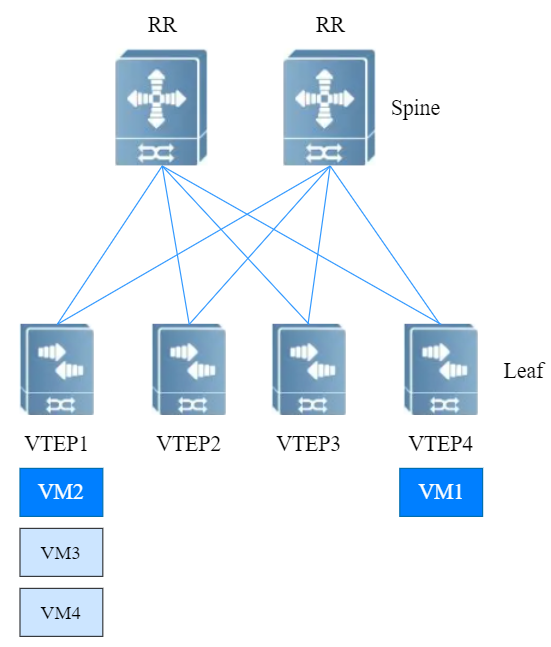Why adopt a distributed VXLAN solution?
|
Centralized VXLAN
|
Distributed VXLAN
|
|
|
Layer 3 gateway location
|
Layer 3 gateway is deployed at Spine
|
Layer 3 gateway is deployed at Leaf
|
|
Layer 2 gateway location
|
Layer 2 gateway is deployed at Leaf
|
Layer 2 gateway is deployed at Leaf
|
|
Traffic forwarding rules
|
Layer 3 traffic under the same -Leaf needs to detour the Spine
|
Layer 3 traffic under the same -Leaf does not need to detour the Spine
|
|
Table item storage rule
|
The Spine needs to store the MAC and ARP of the entire network
|
The Spine does not need to store the MAC and ARP of the entire network
|
|
Control Plane
|
Static or EVPN
|
EVPN
|
|
Operation and Management (O&M)
|
Simple, because the gateway is at Spine
|
Complex, because the gateway is at Leaf
|
|
Applicable Data center scale
|
Suitable for small scale networking
|
Suitable for medium and large scale networking
|
Why EVPN is introduce as the control plane?
|
Static mode
|
IS-IS mode
|
EVPN mode
|
Controller mode
|
|
|
Tunnel Construction method
|
Adopts a static configuration approach
|
ENDP(Enhanced Neighbor Discovery Protocol) must be configured on VTEPs to discover VTEPs and establish tunnels
|
The extended BGP attribute enables neighbor discovery, automatically discovers VTEPs in VXLAN networks, and automatically creates VXLAN tunnels between VTEPs
|
Controller
System-controller
|
|
Tunnel establishment method between VTEPs
|
Adopts a static configuration approach
|
IS-IS protocol extension mode
|
VXLAN tunnels are automatically established through BGP extended attribute associations
|
Controller
System-controller
|
|
Address learning
|
Learns MAC address flooding
|
IS-IS protocol is implemented to learn remote addresses
|
Implementation of extended MP-BGP protocol
|
First packet reported,
The forwarding table item is issued by the Controller
|
|
Standardization
|
No control plane
|
Private protocol, extend IS-IS packets
|
The control protocol of EVPN has been standardized, see RFC 7348RFC7209, RFC7432
|
VTEP and Controller are based on the standard protocol framework Netconf/0penFlow, but each manufacturer has its own private definition, so they are not compatible
|
2. Standardization
Implementation Solution Based on EVPN+VXLAN
Type 3 routing - tunnel establishment
Based on EVPN-Type3 routing - Inclusive Multicast routing1
1This type of routing is mainly used for automatic discovery of VTEPs and dynamic establishment of VXLAN tunnels in the VXLAN control plane. VTEPs that are BGP EVPN peers transmit Layer 2 VNI and VTEP IP address information to each other through Inclusive Multicast routing. In particular, the Originating Router's IP Address field is the local VTEP IP address. If the peer VTEP IP address is reachable by Layer 3 routing, a VXLAN tunnel to the peer is established.
EVPN-Type2 Routing ——MAC and Routing Synchronization
Based on EVPN-Type2 routing - MAC/IP routing2, MAC and routing synchronization in the network can be automatically completed.
2The main functions of this type of routing are: host MAC address notification, host ARP notification, and host IP route notification.
EVPN-Type5 Routing —— Border Routing Access
In this scenario where Underlay and Overlay are interconnected, a relatively important routing type of EVPN will be used - segment routing, which is transmitted through EVPN-Type5 routing - IP prefix routing. When the external route enters the Border, the Border will be synchronized to the VXLAN network through Type5 routing, thereby enabling hosts in the VXLAN network to access the external network.
Optimization of Distributed VXLAN Solution Deployment
When the scale of virtual machines in the network expands, ARP broadcast will consume network bandwidth and there will be a risk of broadcast storm. In order to reduce the impact of ARP broadcast, we can suppress ARP flooding through ARP proxy.
ARP proxy implementation: After the gateway turns on the ARP proxy, the host learns that the remote ARP is the MAC address of the gateway. It has the following advantages:
However, it may not be applicable in some scenarios. For example, the DR mode of LVS requires LVS to learn the real MAC address of the server, so it cannot be replaced by the gateway MAC. In this scenario, we can disable the ARP proxy function of the VNI where the LVS is located to ensure normal communication in the DR mode.
2. Optimization point 2: ARP-TO-HOST

In order to solve this problem, detailed routing or host routing is needed. If you want to configure it manually, the workload is large and it is easy to make mistakes. Currently, a common method is to automatically generate host routing through ARP and publish it to the network.
Implementation method: After the gateway turns on ARP-TO-HOST, the host route is automatically generated according to the ARP table and automatically published to the network.
Summary

Related Blog:
Exploration of Data Center Automated Operation and Maintenance Technology: Zero Configuration of Switches
Technology Feast | How to De-Stack Data Center Network Architecture
Technology Feast | A Brief Discussion on 100G Optical Modules in Data Centers
Research on the Application of Equal Cost Multi-Path (ECMP) Technology in Data Center Networks
Technology Feast | How to build a lossless network for RDMA
Featured blogs
- Ruijie RALB Technology: Revolutionizing Data Center Network Congestion with Advanced Load Balancing
- CXL 3.0: Solving New Memory Problems in Data Centres (Part 2)
- Multi-Tenant Isolation Technology in AIGC Networks—Data Security and Performance Stability
- Multi-dimensional Comparison and Analysis of AIGC Network Card Dual Uplink Technical Architecture
- A Brief Discussion on the Technical Advantages of the LPO Module in the AIGC Computing Power Network











